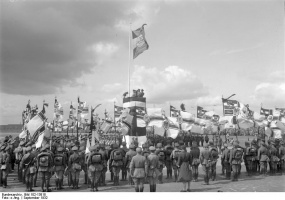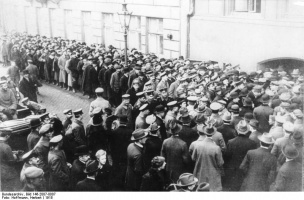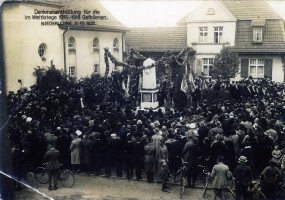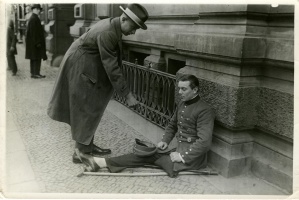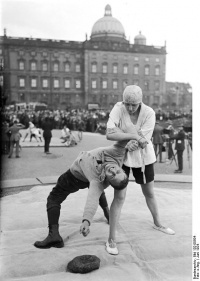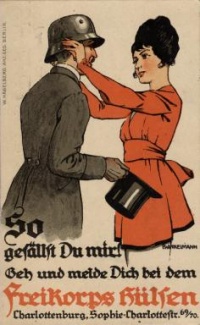Introduction↑
Germany after the First World War remained, as Richard Bessel has put it succinctly, a “post-war society”.[1] This statement points to a key dissonance in Germany after 1918: while the demobilization of the Imperial military and the economic reintegration of returning soldiers took place at unexpected speed, cultural demobilization[2] faced favorable, as well as adverse circumstances and eventually failed. This essay will attempt to explain this dissonance by focusing on three partly intertwined and partly contradictory processes in post-war Germany: 1) a partial “normalization” of material conditions and social relations, driven by a strong desire for this on the part of the population after the turmoil of the war, 2) a cultural liberalization that opened up chances for more individualist life styles, and 3) a militarization of political culture that eventually helped a heroic interpretation of the war experience prevail.
German history after 1918 has been the object of intense research for many decades. Much of this research has addressed the various consequences of the war, mostly in relation to other political, economic, and social issues, while only a limited number of studies have explicitly focused on how Germans came to terms with the legacy of the war. Initially concentrating on the various veterans’ organizations, researchers have subsequently examined the process of demobilization and elite reactions to defeat and the Versailles Treaty, and in recent years have shifted their focus to cultural history, and to questions of war remembrance and its impact on political culture.[3]
In the following remarks, four key aspects of post-war German history will be discussed: 1) the very fundamental and lasting demographic consequences of the war, 2) the process of military and economic demobilization, 3) the various types of veterans’ organizations and the partial remobilization in the civil war of 1919/20, and 4) the forces and counterforces of cultural demobilization. In the conclusion the issue of a broader interpretative framework for understanding post how Germans came to terms with the war will be addressed.
Demographic Consequences of the War↑
Losses↑
Coming to terms with the consequences of mass death was a major challenge for Germans, as it was for the Europeans from other belligerent nations after 1918. About 2 million German soldiers lost their lives in the war and the mortality rate in almost all age groups of the German population exceeded pre-war levels until 1921.[4] These losses, in addition to causing bereavement on an unprecedented scale, resulted in a “profoundly skewed population structure”[5] in two respects. For one, there were now many more women than men, greatly limiting the chances of the 600,000 war widows to remarry. Less than half eventually did, facing conflicting pressures. On the one hand, remarriage could be criticized as a betrayal of the sacrifice of the fallen husband, and on the other hand it was called for as a contribution to rebuilding national strength.[6] Also, the sharp drop of the birth rate during the war raised the proportion of teenagers and adolescents in the German population considerably in the immediate post-war years. As the war had left more than 1 million German children orphaned, this fueled contemporary fears of unruly youngsters who in the minds of some were at risk off breaking free from adult control.[7] If a steep rise in marriages from 1919 to 1923 seemed to indicate a “normalization” of private lives, a concomitant rise of divorces showed that there was no simple “return” to a pre-war “normality”.[8]
Migrations↑
Population movements in the wake of the war also had lasting consequences. While the German Empire lost a population of 6.5 million on account of the territories it had to give up under the Versailles Treaty, until 1925 the smaller Germany of the Weimar Republic actually saw an estimated net growth of about 300,000 people, as an emigration of about 1 million Germans and ethnic Poles was more than offset by the immigration of about 1.3 million people, mostly German citizens from the ceded territories in the East.[9] This substantial immigration was only partially welcomed in Germany, as migrants had to be fed and accommodated in a country exhausted by the war. Also, some having ethnic Germans remaining in Eastern Europe would bolster German claims for, and dreams of, future territorial (re-)expansion there. The border in the East was, therefore, contradictory in character. On the one hand, it was supposed to be fortified to prevent undesired migration to Germany, for example Jewish migration. On the other hand, the border had to be kept provisional in order to facilitate future expansion. The contradictory nature of the border contributed to hampering cultural demobilization.[10]
Military and Economic Demobilization↑
Military (Self-)Demobilization↑
At the time of the armistice, the German army comprised 6 million men. By March 1919, all of them, including those serving in the East had returned home. The speed, at which this process of demobilization unfolded, was remarkable. It was also unexpected, as the army leadership had made plans, released in early 1918, to discharge soldiers gradually. Demobilization, however, began as self-demobilization, voiding all diligent planning. The failure of the spring offensive of 1918 resulted in a “covert military strike” of at least 750,000 soldiers, who in effect laid down their arms by, for example, joining transports of wounded, or “getting lost” on their way to the frontlines from rear areas.[11] While authorities concentrated on preventing high unemployment rates among the returning soldiers, which they feared could lead to unrest, demobilization during the first weeks following the armistice continued to be, at least in part, self-demobilization. An estimated 500,000 soldiers in the West left the army on their own. Almost all soldiers wanted to go straight back to “normal” civilian lives at home. This included most of the former front-line troops from the West after reaching their bases inside Germany in good order, thus thwarting the army leadership’s plan to retain a force of pre-war size. Soldiers arriving in closed units at their bases were, contrary to later claims, welcomed by the local population. They were marched through streets “decorated with flags and flowers” and were given praise for their bravery and endurance. They did not hear, however, unequivocal admissions of defeat. While this helped prevent dissatisfaction among returning soldiers, it also facilitated the subsequent spreading of the stab-in-the-back legend.[12]
Re-Employment and Gender↑
The speedy return of millions of ex-soldiers, coupled with a shortage of raw materials, primarily coal, which hampered industrial production severely, put enormous strains on the German labor market. Unemployment temporarily soared to more than 6 percent in early 1919, with more than 1 million people receiving unemployment benefits. Fortunately, due to concerted efforts of employers, trade unions, and state authorities, this number was halved in the second half of 1919, and by late 1921 had fallen further to 150,000. As there was a broad consensus that returning soldiers should get their former jobs back, many women who had taken up work in the war industries were pushed out of employment. The reduction of the work-day to eight hours, which was agreed upon by employers and trade unions in November 1918, created more demand for labor, as did the massive expansion of the public sector, coupled with public-works projects, and the temporary retaining of war-time contracts by the national government. This was, however, a somewhat uneasy “normalization”, as not every woman worker readily accepted the – eventually only partial - reconstitution of the traditional gender order in industry. Also, the reduction of unemployment came at the cost of an inflation that, having spiraled out of control in the hyperinflation of 1923, led to a painful stabilization with substantial unemployment in its wake.[13]
Veterans’ Organizations and Partial Remobilization↑
Disabled Veterans↑
While for the most part the regular German army disappeared in the process of self-demobilization, war veterans remained a public presence. A total of 1.4 million disabled veterans by the end of 1919 were represented by seven organizations, marked by a mutual hostility that mirrored the profound political cleavages in German society. By far the largest was the “Reichsbund der Kriegsbeschädigten und ehemaligen Kriegsteilnehmer” (“National Association of Disabled Soldiers and Veterans”) with over 600,000 members and ties to the Social Democrats.[14] The new republic, by comparison, proved fairly generous in caring for disabled veterans by providing them with occupational training and free medical care and pensions, and by granting particular protection through the reservation of some jobs for the severely disabled. However, this eventually led to the creation of expectations that the republic could not fulfill, especially in the wake of inflation. Widespread dissatisfaction was the result, as veterans complained about lacking recognition, and the public rejected veterans’ demands as excessive.[15]
Veterans and Remobilization↑
Veterans also reappeared as fighting soldiers, when the provisional government failed in its attempts to build up a reliable military force based on the principle of soldiers electing their officers, it authorized the formation of free corps in January 1919, made up of volunteers who were former officers of the Imperial army. Eventually there were over 100 free corps comprising a maximum of 250,000 men, and including both war veterans and younger volunteers, who had, at best, shaky loyalty to the republic. Fighting against Bolshevik, Baltic, and Polish forces as well as putting down leftist uprisings in several regions of Germany with sometimes ruthless brutality, the free corps fostered a subculture of “ultra-militant masculinity”. This subculture carried over into right-wing extremist movements after the dissolution of the free corps, and thus contributed to the militarization of political culture in Germany.[16]
A New Type of Veterans’ Organization↑
Once the civil war of 1919/20 was over and the free corps had been disbanded as a consequence of the Versailles Treaty, the veterans’ public presence took yet another form that would have a lasting effect on German political culture: the “Wehrverband” (combat league). Its model was the “Stahlhelm” (“steel helmet”), founded in the city of Magdeburg in December 1918 as a local, non-partisan association of veterans coming together for support and socialization. In the summer of 1919, the Stahlhelm grew into a national organization, claiming 260,000 members by 1925, and took on a rightist political profile. Its distinguishing feature was not, however, its rather vague program, but its political style. Through the “street politics” of flag consecrations, mass rallies, and marching in uniform on occasions such as election campaigns, the Stahlhelm gave conservative nationalists a robust and military-like presence in public space.[17] Committed republicans reacted only after the severe crisis of the hyperinflation of 1923 with the founding of the “Reichsbanner Schwarz-Rot-Gold. Bund republikanischer Kriegsteilnehmer” (“Reichsbanner Black-Red-Gold. League of Republican War Veterans”) in 1924. This group succeeded in organizing substantially more veterans in the mid-1920s – about 600,000, most of them Social Democrats – than the Stahlhelm and other veterans’ organizations on the right.[18] While the Reichsbanner contributed to the militarization of political culture more in style than in substance, the Communist “Rote Frontkämpferbund“ (“Red Front-Fighters’ League”), also founded in 1924, and considerably smaller than the Reichsbanner and the Stahlhelm, moved aggressively against its opponents, primarily those on the right.[19] Claiming the true interpretation of the war experience to legitimize a militant style of politics had become a successful strategy of political mobilization by the mid-1920s.
Cultural Demobilization?↑
The combat leagues became the key driving force of the militarization of political culture. It is important to note, however, that this was a gradual process and that domestic militarization was only in part tantamount to cultural remobilization against the victors of the war. As the fate of the Weimar Republic, together with its approach to former enemies was only decided in its final years, cultural demobilization was not without its chances to succeed.
Mass Culture↑
One supporting factor deserving greater recognition was a trend toward cultural liberalization for which the war had paved the way. For young people, in particular for those who were old enough to work in the war industries but still too young to serve in the military, the war, despite all its hardships, also had liberating effects, as many figures of authority, such as teachers and policemen, were no longer present, and substantial wages provided novel opportunities for consumption.[20] After the revolution had further undermined traditional social hierarchies and control of mass culture, the inflationary boom that began in late 1919 and the new eight-hour work day gave another boost to consumption and offered chances for a more individual life style. This liberalization, while mainly an urban phenomenon, certainly contributed to cultural demobilization.[21]
However, mass culture also had very ambivalent effects, as becomes evident when looking at the example of sports, the most widespread leisure activity. Membership in an increasing variety of sports associations – more than 5 million in 1925 – clearly surpassed that of the combat leagues.[22] Given that athletes also became role models and some, such as male tennis players who displayed a “soft” and hedonistic masculinity, challenged traditional notions of gender roles head-on.[23] In this way, sports at once reinforced cultural liberalization and also contributed to cultural demobilization. On the other hand, sports also had a contrasting effect. Sports officials, along with military leaders, wanted the training that their organizations provided to be a kind of compensation for the ban on universal male conscription that the Versailles Treaty imposed. Moreover, the major associations of university students, including extreme nationalists and key actors in the military remobilization of 1919/20, made physical training, for example in track and fields, swimming, and soccer, mandatory for their members after the war.[24]
Remembering and Interpreting the War↑
As Germany’s old elites for the most part refused to acknowledge that the German army had been defeated – which was facilitated by the lack of decisive battle in the fall of 1918 –, the stab-in-the-back legend found widespread acceptance.[25] The Versailles Treaty, and in particular its war guilt clause, was met with almost universal rejection. The Social Democrats only admitted cautiously that the leadership of Imperial Germany had to bear responsibility for the war to a limited extent.[26] While this created a presence of the war in peacetime that militated against cultural demobilization, other forms of remembering the war present a more complicated picture. War memorials, erected all over Germany after 1918, stood out for the variety of their forms and the multiple readings they suggested. Only a few conveyed an outright revanchist message. Most centered on mourning, using religious symbols, figurative imagery, or (and this was increasingly so around 1930) abstract forms. In the mid-1920s, figurative depictions of soldiers, that emphasizing an idealized and static posture took on more naturalistic and dynamic features, facilitating, but not exclusively suggesting, a heroic reading. Plans for a national memorial did not materialize because of disagreements over its aesthetic form and the unwillingness of the rightist veterans’ associations to cooperate with the Reichsbanner.[27]
Organized veterans’ associations’ interpretations of the war differed sharply. The Stahlhelm offered an unequivocally heroic reading, celebrating the virtues of the frontline fighter and the alleged “community of the trenches” and propagating them as models for rebuilding Germany’s political and moral order.[28] The Reichsbanner, its main opponent, supported by the Reichsbund, proposed a contrasting interpretation that emphasized the brutality of the war and the hardships the soldiers had to endure, as well as the tension-ridden relationship between officers and enlisted men. By advocating a policy of mutual understanding and peaceful conflict resolution vis-à-vis Germany’s former enemies, the Reichsbanner made a “substantial” contribution to cultural demobilization, even though not all of its members were absolute pacifists.[29]
The definitive shift towards a hegemony of a rightist, and essentially revanchist, interpretation of the war, and the effective termination of cultural demobilization, occurred only around 1930 and resulted from a combination of factors. As the memory of the hardships of the war faded, portraying soldiers as victims finally lost its appeal to a heroic reading, which did not deprive them of agency, and now gained some ground even in the Reichsbanner.[30] A spate of novels and movies about the war, largely supporting its heroic interpretation reinforced this shift.[31] By the time of the Great Depression and the breakthrough of National Socialists in the elections of 1930, the Social Democrats had been removed both from the national government (in 1930), and from the government in Prussia (in 1932). The rightist shift of political hegemony in Germany was complete.
Conclusion↑
Cultural demobilization in post-war Germany did not fail for a lack of committed republicans and pacifists, but because their enemies on the right succeeded in forcing them to present their interpretation of the war within the framework of a militarized political culture, and because by the end of the 1920s overall political and economic circumstances did not work in the republicans’ favor. The “normalization” that the speedy military and economic demobilization helped bring about remained tenuous and cultural liberalization with its individualistic bent could not generate an effective counter-narrative to a community-oriented war remembrance. Describing the result of the failed cultural demobilization as a “brutalization”, which has been an influential narrative, is only partly appropriate, however.[32] Veterans whose war experiences led them to volunteer for the free corps and join combat leagues comprised only a minority among all veterans. Even the gradual militarization of political culture can only be seen to some extent as a brutalization, as this interpretation overlooks the profound pacifism among many committed republicans and marginalizes the effects of the multifaceted mass culture on German society. It seems more appropriate to describe post-war Germany as marked by, in essence, two opposing “cultures of defeat”,[33] one drawing an ultimately revanchist lesson from the war, the other conveying an essentially pacifist message.
Dirk Schumann, Georg-August-Universität Göttingen
Section Editor: Christoph Cornelißen
Notes
- ↑ Bessel, Richard: Germany After the First World War, Oxford 1993, p. 283.
- ↑ For a discussion of the concept of "cultural demobilization" see Horne, John: Kulturelle Demobilmachung – ein sinnvoller Begriff?, in: Hardtwig, Wolfgang (ed.): Politische Kulturgeschichte der Zwischenkriegszeit 1918-1939, Göttingen 2005, pp. 129-150.
- ↑ For a general overview of research on Weimar Germany see Kolb, Eberhard/Schumann, Dirk: Die Weimarer Republik, 8th Edition, Munich 2013; cf. McElligott, Anthony (ed.): Weimar Germany, Oxford 2009; Stibbe, Matthew: Germany, 1914-1933. Politics, Society and Culture, Harlow 2010. A helpful, while not fully satisfactory, introduction to recent research on the legacy of the war is provided by Beaupré, Nicolas: Das Trauma des großen Krieges 1918-1932/33, Darmstadt 2009.
- ↑ Bessel, Germany 1993, p. 224; Meerwarth, Rudolf: Die Entwicklung der Bevölkerung in Deutschland während der Kriegs- und Nachkriegszeit, in: Meerwarth, Rudolf/Günther, Adolf/Zimmermann, Waldemar (eds.): Die Einwirkung des Krieges auf Bevölkerungsbewegung, Einkommen und Lebenshaltung in Deutschland, Stuttgart 1932, pp. 1-97, here pp. 69, 62f., 65.
- ↑ Bessel, Germany 1993, p. 225.
- ↑ Bessel, Germany 1993, p. 225f.; Kuhlman, Erika: Of Little Comfort. War Widows, Fallen Soldiers, and the Remaking of the Nation after the Great War, New York 2012, in particular p. 127ff.
- ↑ Bessel, Germany 1993, pp. 225, 227. By 1925, those between fifteen and twenty-five years of age still made up more than a fifth of the German population according to Meerwarth, Entwicklung 1932, p. 87.
- ↑ Bessel, Germany 1993, pp. 228-230.
- ↑ Meerwarth, Entwicklung, p. 85.
- ↑ Oltmer, Jochen: Migration und Politik in der Weimarer Republik, Göttingen 2005; Sammartino, Annemarie H.: The Impossible Border. Germany and the East, 1914-1922, Ithaca 2010.
- ↑ Deist, Wilhelm: Verdeckter Militärstreik im Kriegsjahr 1918?, in: Wette, Wolfram (ed.): Der Krieg des kleinen Mannes, Munich 1992, pp. 146-167.
- ↑ Bessel, Germany 1993, pp. 52-89, the figures on pp. 73 and 75, and the quote on p. 85; Stephenson, Scott: The Final Battle. Soldiers of the Western Front and the German Revolution of 1918, Cambridge 2009.
- ↑ Bessel, Germany 1993, pp. 93-165, for the figures pp.102, 129f.; Rouette, Susanne: Sozialpolitik als Geschlechterpolitik. Die Regulierung der Frauenarbeit nach dem Ersten Weltkrieg, Frankfurt 1993; Feldman, Gerald D.: The Great Disorder. Politics, Economics, and Society in the German Inflation, 1914-1924, New York 1993, in particular pp. 99-131. The overall trend of increasing gainful employment for women, which was most pronounced in, but not limited to, clerical work, continued through the 1920s. See Bajohr, Stefan: Die Hälfte der Fabrik. Geschichte der Frauenarbeit in Deutschland, 1914-1945, Marburg 1979, p. 168f.
- ↑ Whalen, Robert Weldon: Bitter Wounds. German Victims of the Great War, 1914-1939, Ithaca 1984, pp. 107-129.
- ↑ Cohen, Deborah: The War Come Home. Disabled Veterans in Britain and Germany, 1914-1939, Berkeley 2001, pp. 62-94, 149-162. Former prisoners of war, who were faced with allegations of having been “shirkers” (“Drückeberger”), were another group of veterans fighting for appropriate recognition and financial compensation in the post-war years. See Pöppinghege, Rainer: ‘Kriegsteilnehmer zweiter Klasse?’. Die Reichsvereinigung ehemaliger Kriegsgefangener 1919-1933, in: Militärgeschichtliche Zeitschrift 64 (2005), pp. 391-423.
- ↑ Schulze, Hagen: Freikorps und Republik 1918-1920, Boppard 1969; Gerwarth, Robert/Horne, John: War in Peace. Paramilitary Violence in Europe after the Great War, Oxford 2012, the quote on p. 59.
- ↑ Berghahn, Volker R.: Der Stahlhelm, Bund der Frontsoldaten 1918-1935, Düsseldorf 1966, pp. 5-101, the figure on p. 85; Schumann, Dirk: Political Violence in Weimar Germany 1918-1933: Fight for the Streets and Fear of Civil War, New York 2009, pp. 92-95, 187-189.
- ↑ Ziemann, Benjamin: Contested Commemorations. Republican War Veterans and Weimar Political Culture, Cambridge 2013, p. 67; Rohe, Karl: Das Reichsbanner Schwarz-Rot-Gold. Ein Beitrag zur Geschichte und Struktur der politischen Kampfverbände zur Zeit der Weimarer Republik, Düsseldorf 1966.
- ↑ Schuster, Kurt P.: Der Rote Frontkämpferbund 1924-1929. Beiträge zur Geschichte und Organisationsstruktur eines politischen Kampfbundes, Düsseldorf 1975. A comprehensive history of the various combat leagues is provided by Diehl, James N.: Paramilitary Politics in Weimar Germany, Bloomington 1977.
- ↑ Donson, Andrew: Youth in the Fatherless Land. War Pedagogy, Nationalism, and Authority in Germany, 1914-1918, Cambridge 2010, pp. 225-229.
- ↑ Geyer, Martin H.: Verkehrte Welt: Revolution, Inflation und Moderne. München, 1914-1924, Göttingen 1998, pp. 70-75, 267-273.
- ↑ Eisenberg, Christiane: ”English Sports“ und deutsche Bürger. Eine Gesellschaftsgeschichte, 1800-1939, Paderborn 1999, p. 329f.
- ↑ Jensen, Erik Norman: Body by Weimar. Athletes, Gender, and German Modernity, Oxford 2010.
- ↑ Eisenberg, "English Sports" 1999, pp. 323-335; Levsen, Sonja: Elite, Männlichkeit und Krieg. Tübinger und Cambridger Studenten 1900-1929, Göttingen 2005, pp. 256-263, 279-288, 296-302.
- ↑ Barth, Boris: Dolchstoßlegenden und politische Desintegration. Das Trauma der deutschen Niederlage im Ersten Weltkrieg, 1914-1933, Düsseldorf 2003.
- ↑ Heinemann, Manfred: Die verdrängte Niederlage. Politische Öffentlichkeit und Kriegsschuldfrage in der Weimarer Republik, Göttingen 1983.
- ↑ Saehrendt, Christian: Der Stellungskrieg der Denkmäler. Kriegerdenkmäler im Berlin der Zwischenkriegszeit (1919-1939), Bonn 2004, in particular p. 57f.; Ziemann, Benjamin: Die deutsche Nation und ihr zentraler Erinnerungsort. Das ‚Nationaldenkmal für die Gefallenen des Weltkrieges’ und die Idee des Unbekannten Soldaten 1914-1935, in: Berding, Helmut/Heller, Klaus/Speitkamp, Winfried (eds.): Krieg und Erinnerung. Fallstudien zum 19. und 20. Jahrhundert, Göttingen 2000, pp. 67-91.
- ↑ Schumann, Violence 2009, pp.188-196.
- ↑ Ziemann, Contested 2013, the quote on p. 268. While Ziemann stresses the pacifism of rank-and-file Reichsbanner members, in Rohe’s Reichsbanner, the support of Reichsbanner leadership for a republican German military and the principle of self-defense is emphasized. The pacifist movement itself enjoyed mass support in the first years of the Weimar Republic, with tens of thousands of participants flocking to its rallies, but it saw a considerable decline following the French occupation of the Ruhr area in 1923. See Lütgemeier-Davin, Reinhold: Basis-Mobilisierung gegen den Krieg. Die Nie-Wieder-Krieg-Bewegung in der Weimarer Republik, in: Holl, Karl/Wette, Wolfram (eds.), Pazifismus in der Weimarer Republik, Paderborn 1981, pp. 47-76.
- ↑ Weinrich, Arndt: Der Weltkrieg als Erzieher. Jugend zwischen Weimarer Republik und NS, Essen 2011, p. 108-124; Ziemann, Contested 2013, p. 272f.
- ↑ Schöning, Matthias: Versprengte Gemeinschaft. Kriegsroman und intellektuelle Mobilmachung in Deutschland 1914 – 1933, Göttingen 2009; Kester, Bernadette: Film Front Weimar. Representations of the First World War in German Films from the Weimar Period (1919-1933), Amsterdam 2002.
- ↑ For an introduction to this debate see Schumann, Dirk: Gewalterfahrungen und ihre nicht zwangsläufigen Folgen. Der Erste Weltkrieg in der Gewaltgeschichte des 20. Jahrhunderts. In: Zeitgeschichte-online, Thema: Fronterlebnis und Nachkriegsordnung. Wirkung und Wahrnehmung des Ersten Weltkriegs, Mai 2004, URL: http://www.zeitgeschichte-online.de/md=EWK-Schumann.
- ↑ This substantially modifies the notion of one coherent “culture of defeat”, as proposed by Schivelbusch, Wolfgang: Die Kultur der Niederlage. Der amerikanische Süden 1865, Frankreich 1871, Deutschland 1918, Berlin 2001 (Engl. transl. 2003), p. 225ff; cf. Horne, Kulturelle Demobilmachung 2005, p.143-147. Dülffer, Jost/Krumeich, Gerd (eds.): Der verlorene Frieden. Politik und Kriegskultur nach 1918, Essen 2002, provide a variety of perspectives on the concept of ”brutalization“.
Selected Bibliography
- Berghahn, Volker R.: Der Stahlhelm. Bund der Frontsoldaten 1918-1935, Düsseldorf 1966: Drosto.
- Cohen, Deborah: The war come home. Disabled veterans in Britain and Germany, 1914-1939, Berkeley 2008: University of California Press.
- Diehl, James M.: Paramilitary politics in Weimar Germany, Bloomington 1977: Indiana University Press.
- Dülffer, Jost / Krumeich, Gerd (eds.): Der verlorene Frieden. Politik und Kriegskultur nach 1918, Essen 2002: Klartext Verlag.
- Gerwarth, Robert / Horne, John (eds.): War in peace. Paramilitary violence in Europe after the Great War, Oxford 2012: Oxford University Press.
- Kester, Bernadette: Film front Weimar. Representations of the First World War in german films of the Weimar period, 1919-1933, Amsterdam 2003: Amsterdam University Press.
- Rohe, Karl: Das Reichsbanner Schwarz Rot Gold. Ein Beitrag zur Geschichte und Struktur der politischen Kampfverbände zur Zeit der Weimarer Republik, Düsseldorf 1966: Droste.
- Saehrendt, Christian: Der Stellungskrieg der Denkmäler. Kriegerdenkmäler im Berlin der Zwischenkriegszeit (1919-1939), Bonn 2004: Dietz.
- Schöning, Matthias: Versprengte Gemeinschaft. Kriegsroman und intellektuelle Mobilmachung in Deutschland 1914-1933, Göttingen 2009: Vandenhoeck & Ruprecht.
- Schumann, Dirk: Political violence in the Weimar Republic, 1918-1933. Fight for the streets and fear of civil war, New York 2009: Berghahn Books.
- Weinrich, Arndt: Der Weltkrieg als Erzieher. Jugend zwischen Weimarer Republik und Nationalsozialismus, Essen 2012: Klartext Verlag.
- Whalen, Robert Weldon: Bitter wounds. German victims of the Great War, 1914-1939, Ithaca 1984: Cornell University Press.
- Ziemann, Benjamin: Contested commemorations. Republican war veterans and Weimar political culture, Cambridge; New York 2013: Cambridge University Press.





